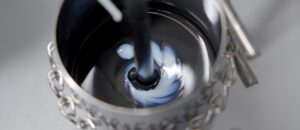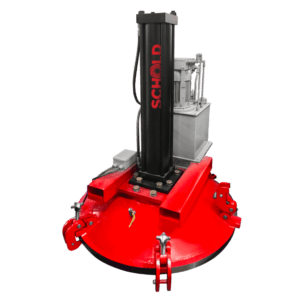Mixing Equipment for Batteries | Proper Slurry Mixing
Overview
The battery industry is at the forefront of technological advancement, driving innovation in energy storage and electrification. To meet the requirements of this industry, precision equipment plays a crucial role in every stage of battery production. At Schold, we understand the critical importance of specialized mixing equipment for batteries and their applications. This post will highlight slurry mixing and equipment used to ensure optimal battery performance.
The Importance of Proper Slurry Mixing
An electrode slurry is a mixture of active material, conductive additives, solvents, and binders. This mixture is applied onto copper and aluminum foil, followed by drying and calendaring, to form the cathode and anode in the battery cell. The active materials are the reacting lithium ions, while the conductive additives facilitate electron conductivity. Optimizing the ratio of active material to conductive additives is crucial for high-capacity lithium-ion batteries, as it enhances electron conductivity and minimizes internal battery resistance.
Proper mixing ensures maximum contact of the electrolyte and the active material, increasing ionic reaction and battery capacity. Poor mixing can result in inefficient electron conduction and non-uniform battery reactions, leading to decreased performance and capacity. Homogeneous dispersion of the active material into the binder solution is crucial for consistent battery performance, as agglomerates can cause issues during coating operations and affect battery capacity.
For more insight on slurry mixing in battery production, visit Stir it Up: The Importance of Slurry Mixing in Batteries by Barry Perlmutter.
Mixing Equipment for Batteries
To achieve the precise mixing required in battery manufacturing, several types of equipment are utilized. Below are the key pieces of mixing equipment for batteries and their applications within the industry:
Mixers and Blenders
Planetary Mixers
These mixers are indispensable for creating electrode pastes and slurries in battery manufacturing. They ensure a thorough and homogeneous blend of active materials, binders, and conductive additives, crucial for achieving consistent electrode quality and maximizing energy density in batteries. Planetary mixers, which include two or three multi-hinged blades, facilitate up-and-down as well as around-the-cylinder material flow, producing a quick and effective mixing effect. Contact Schold for planetary mixer options!
Double Planetary Mixers
Similar to planetary mixers, double planetary mixers are utilized for precise mixing of high-viscosity materials, such as electrode pastes and thick slurries. Their dual-action mixing ensures thorough dispersion and uniformity of components, contributing to improved battery performance and reliability.
Ribbon Blenders →
Ribbon blenders can be used for blending dry powders and granules, creating uniform mixtures that are essential for preparing materials before they are processed into electrode slurries. Example: Multi-Shaft Mixers
Dispersers
High-Speed Dispersers →
These play a critical role in dispersing and deagglomerating powders and solids into liquid carriers, ensuring uniform dispersion of materials in electrode pastes and slurries. They optimize rheological properties and electrochemical performance, key factors in battery quality and efficiency. Examples: LMX Laboratory High-Speed Disperser and VHS High-Speed Disperser
Ultrasonic Dispersers
Employed to create fine particle dispersions, ultrasonic dispersers break down agglomerates and ensure uniform distribution of particles in battery materials. This technology contributes to enhanced electrode performance and prolonged cycle life.
Rotor-Stator Dispersers
These dispersers are used in battery manufacturing for achieving fine dispersion of materials in electrode formulations. They work by creating intense shear forces between a rotating rotor and a stationary stator, resulting in efficient dispersion and deagglomeration of particles, crucial for the homogeneity and performance of battery electrode materials. Example: VRS Rotor Stator
Mills and Grinders
Bead Mills →
Widely used for achieving nano-level dispersion of materials in battery electrode formulations, bead mills contribute to improved energy density and electrode performance. They help in reducing particle size and promoting uniform distribution, essential for optimizing the electrochemical properties of the battery materials. Examples: EMI Laboratory Bead Mill and HSM Horizontal Media Mill
Ball Mills
These are extensively used to grind and refine electrode materials and conductive additives, optimizing particle size and morphology for enhanced battery performance. Ball mills ensure uniform particle distribution and control the surface area of active materials, directly impacting battery capacity and efficiency.
Attritors
In the battery industry, attritors are employed for grinding and blending various materials to achieve precise particle size reduction and material homogenization. This ensures consistent properties in electrode components, which is vital for maintaining battery quality and performance.
Extruders and Discharge Presses
Extruders
Crucial for shaping electrode materials into specific forms such as pastes or films, extruders enable precise control over electrode thickness and density, ensuring uniformity and structural integrity in batteries. Extruders are particularly valuable for creating consistent layers of electrode materials, which are essential for battery performance and longevity.
Discharge Presses →
Essential for compacting electrode materials into electrodes with precise thickness and density, presses contribute to consistent electrochemical performance and energy storage capabilities of batteries. By applying controlled pressure, presses help achieve the desired electrode properties, which are critical for battery efficiency and reliability. Example: Portable Discharge Press
Mixing Tanks and Reactors
Mixing Tanks →
Large-scale mixing tanks are vital for preparing electrolyte solutions, coating materials, and chemical formulations in battery manufacturing. They enable thorough mixing and blending of components, ensuring uniformity and consistency in battery production processes. These tanks are designed to handle large volumes of material, facilitating efficient and scalable production. Example: Mixing Tanks and Totes
Reactors
Utilized for chemical reactions and processing, reactors play a role in preparing electrode materials, electrolytes, and other chemical formulations critical for battery performance. Reactors ensure controlled environments for chemical processes, contributing to the quality and stability of battery materials.
Need battery mixing equipment? If so, let’s get started.
Discover Schold’s mixing equipment for batteries – Explore configurations, learn about customizable options, and optimize your battery production.







